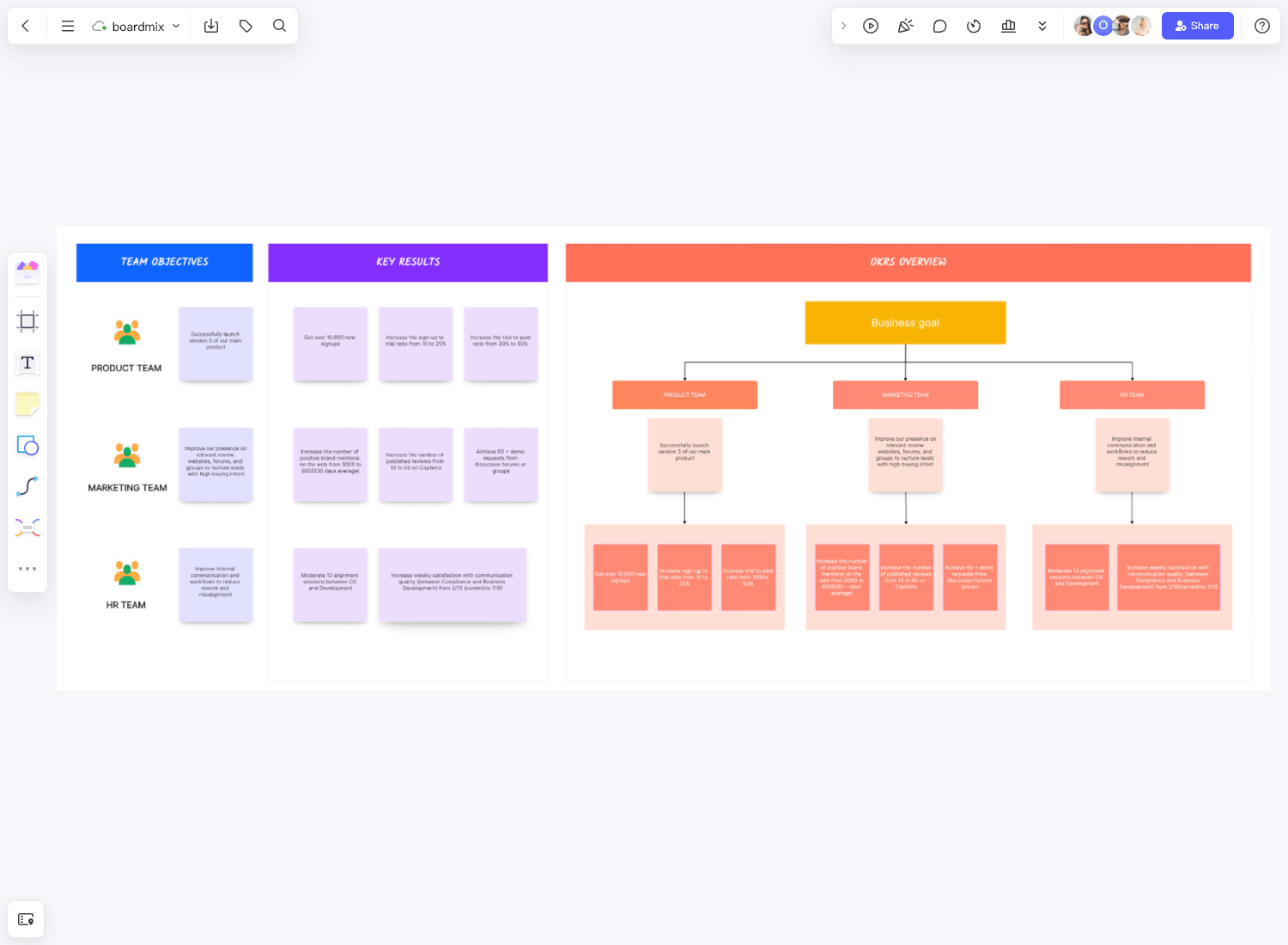Whether it’s a marketing strategy or product launch, a company will always involve creating objectives, tracking progress, and measuring results. Of course, you have to list all these elements. One can use different goal-setting diagrams, like an OKR template, to do so. The template allows teams to define their vision and use metrics to assess the outcome to improve product usage, adoption, and growth among target customers.
What are objectives and key results (OKRs)?

Those familiar with strategic planning are already familiar with Objectives and Key Results or OKRs. This concept was derived from the MBO or Management by Objective idea, which Peter Drucker first introduced during the 1950s. It aimed to boost employee engagement by letting people have a voice through their professional goal-setting.
Meanwhile, the OKR planning concept was later developed in the 1970s by Intel CEO Andy Grove and was popularized by John Doerr upon introducing it at Google. Grove outlined the idea using two questions: ‘Where do I want to go?’ (Objective) and ‘How will I pace myself to see if I am getting there?’ (Key results). The idea aims to think of what you want to achieve along with your metrics for success.
What is the OKR planning template?
Essentially, the OKR planning template allows teams to run OKR sessions flawlessly. The template guides you on leading every part of the OKR process with pre-filled sections and concise instructions. The framework helps your team focus and align with the results and business objectives with actionable initiatives.
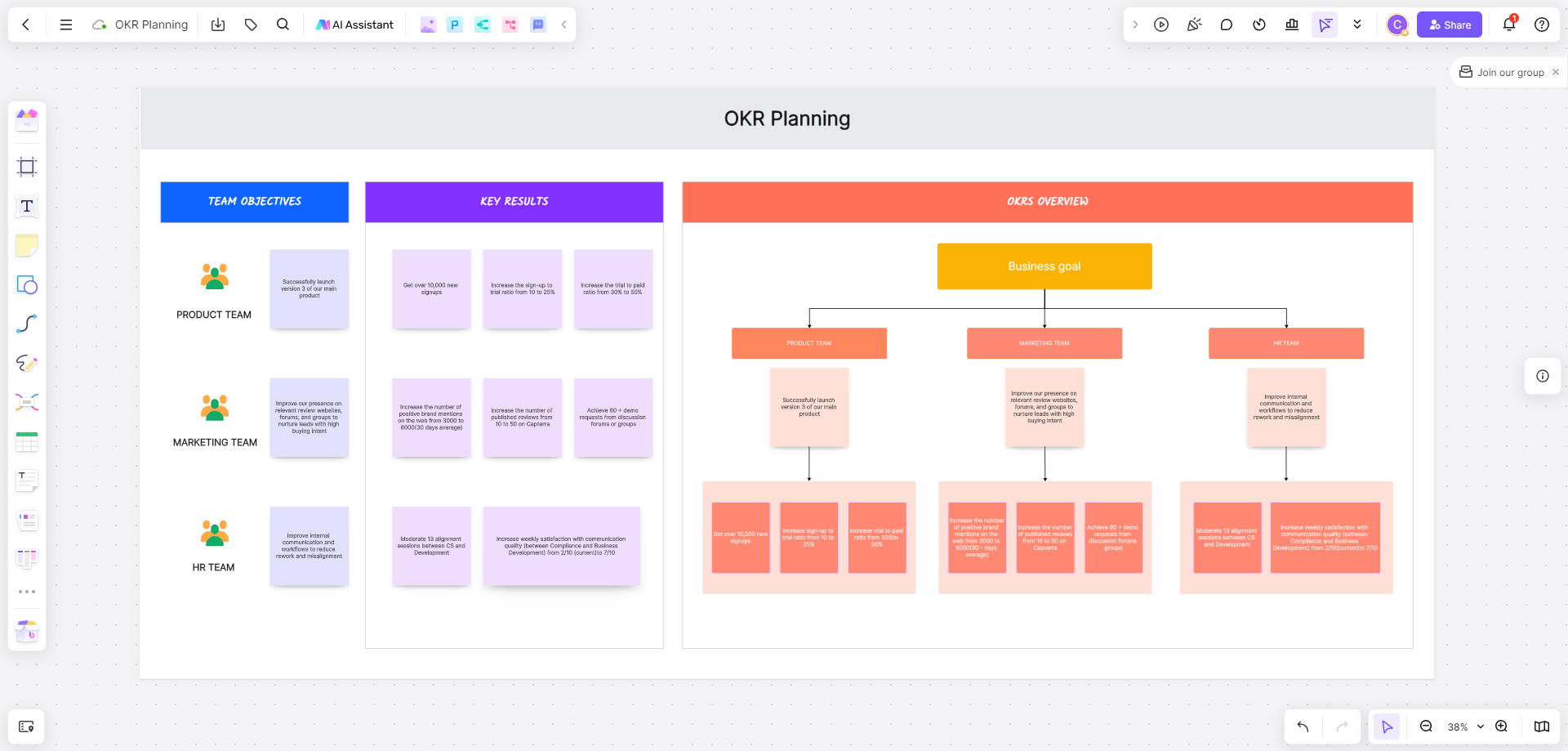
Most companies and organizations use a digital OKR template so members can edit the sections that need changes. The structure comprises six frames that guide you before, during, and after OKR planning sessions. Furthermore, you can collaborate better with team members, even virtually, since the digital templates are accessible using a specific link.
Benefits of using the OKR planning template
OKR planning has had much success in businesses and organizations. They consider the framework valuable for impacting culture, engagements, business outcomes, and communication. Check out more advantages of using the OKR planning template from the list below.
- Team alignment. The OKR connects individual and team goals and initiatives that gear toward the company’s strategic mission. Essentially, top managers will create their company-wide OKRs. From that OKR, departments, and units will also have their OKRs to contribute to achieving company objectives.
- In most cases, an OKR involves a shorter goal cycle allowing companies to adjust and adapt to possible changes, reducing waste and risks. With a strategic OKR planning template, you can expect it to be set for one year. At the end of every cycle, teams will analyze the results and change the strategic OKR if necessary.
- Employee engagement. Allowing team members to get involved and be aligned with the company’s goals through OKR planning increases motivation and engagement. As you already know, higher employee engagement boosts job satisfaction and productivity.
- Focus team. The OKR only has significant objectives for the company. Instead of having a long list of goals, the template will likely have 2-4 goals for every team or individual; meanwhile, the key results range from 3-5. As a result, the company can focus on the specific agenda, and any item outside the current objectives can be removed for the next cycle.
- About 60% of the OKRs are set mainly by individuals and team members instead of their managers. This approach gives each member a sense of responsibility for the objectives they made and will be more motivated to achieve them.
OKR Planning Template in Boardmix
OKR Example 1: Company Performance Appraisal
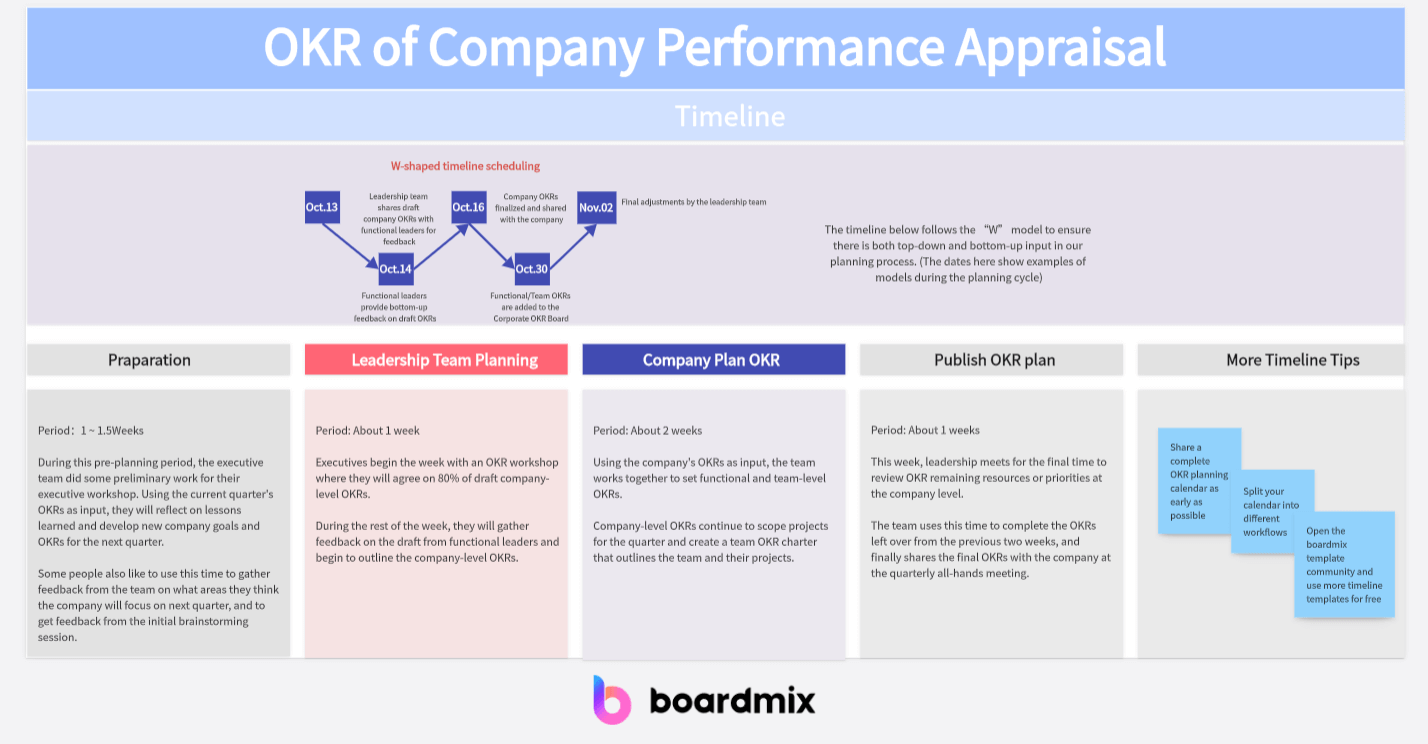
OKR is an effective goal management tool that can permeate corporate goals from the top leadership to the grassroots. Here is an OKR example of a company performance appraisal:
Objective: Improve the efficiency and accuracy of the company's performance appraisal.
Key Results:
1. Reduce the time consumption of appraisals by 25% in the next quarter through automation tools.
2. Increase the score of "satisfaction with performance appraisal" in employee satisfaction surveys, at least reaching 8 points (out of 10).
3. For all performance indicators, raise the fairness assessment score to above 90%.
This OKR example can be used to guide and measure the optimization work of the performance appraisal system, thereby improving its efficiency and accuracy, while also bringing higher employee satisfaction. Please note that this OKR can be adjusted and modified according to your company's specific needs.
OKR Example 2: Online Marketing Planning

Online marketing OKR (objectives and key results) planning refers to the process of setting clear goals and key results for online marketing activities. Its purpose is to help teams clarify their goals, stay focused, and work together to achieve them. The following is an example of OKR for online marketing planning.
Objective: Increase our brand’s online presence
Key Results:
1. Within the next quarter, attract 10,000 new followers across social media platforms.
Increase website traffic by 20%.
2. Successfully conducted 10 influential industry cooperations.
This OKR example can help online marketing teams plan their campaigns more effectively and improve their productivity, while also providing them with direction in the pursuit of their goals.
OKR Example 3: Team Brainstorming
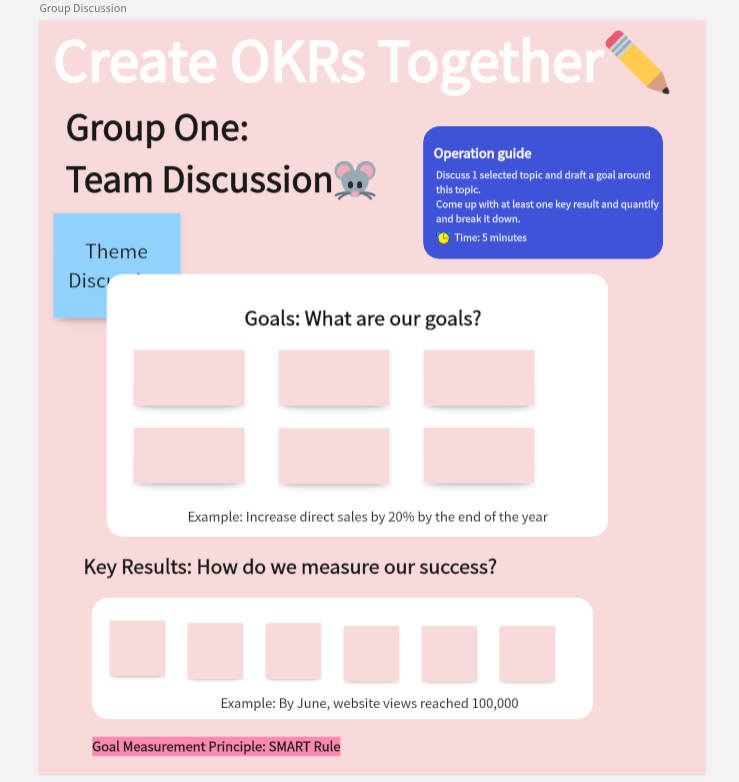
The online team collaboration platform Boardmix whiteboard allows teams to adopt OKR (objectives and key results) management methods in the form of brainstorming and team co-creation. Here is an example of OKRs for team brainstorming:
Step:
1. Set team OKR goals: Before starting the project, choose the highest-level goal as the team’s OKR goal.
2. Determine the top three issues through voting: Determine the top three issues that need priority discussion and resolution through voting.
3. Group drafting goals: After identifying the topics, team members work in groups to jointly draft specific goals that need to be achieved to achieve these topics.
4. Team Proposal Speech: After drafting the goals, each team will give a proposal speech to explain in detail how their goals and plans will help achieve the team's OKR goals.
The above process helps to quickly create OKRs with team members, which not only improves team collaboration efficiency but also enables each member to participate in the goal-setting process, further enhancing team cohesion.
How to use the OKR planning template?
As previously discussed in this article, there are essential steps you can follow to ensure a well-curated OKR template. These include the following:
- Conduct an icebreaker for the team. It pays for creative insights from your members, so an icebreaker can be an excellent start.
- Discuss the goals and topics. You can now outline the agenda of your meeting by presenting significant information your team might need for the OKR session. It may include company metrics or statistics.
- Encourage questions and answers. Once the OKR session has been established, let your team members raise concerns and ask questions. As the moderator, you must listen actively and understand their worries and concerns. These inputs will be beneficial to the session to run smoothly.
- Discuss with your team which areas you must focus on for your OKR. You can use the voting system to give everyone a voice and engage in your discussions.
- Group your teams to have their OKRs. Each group can discuss the topics laid out during the brainstorming session. Members can develop actionable points and key results to achieve company objectives.
- Define the OKR framework. This is now the time to gather everything from the groups to outline key results rationale, projects, dependencies, owners, and status for each objective. After creating the template, ensure a follow-up meeting to ensure everyone is aligned.
Simplifying OKR Planning with Boardmix
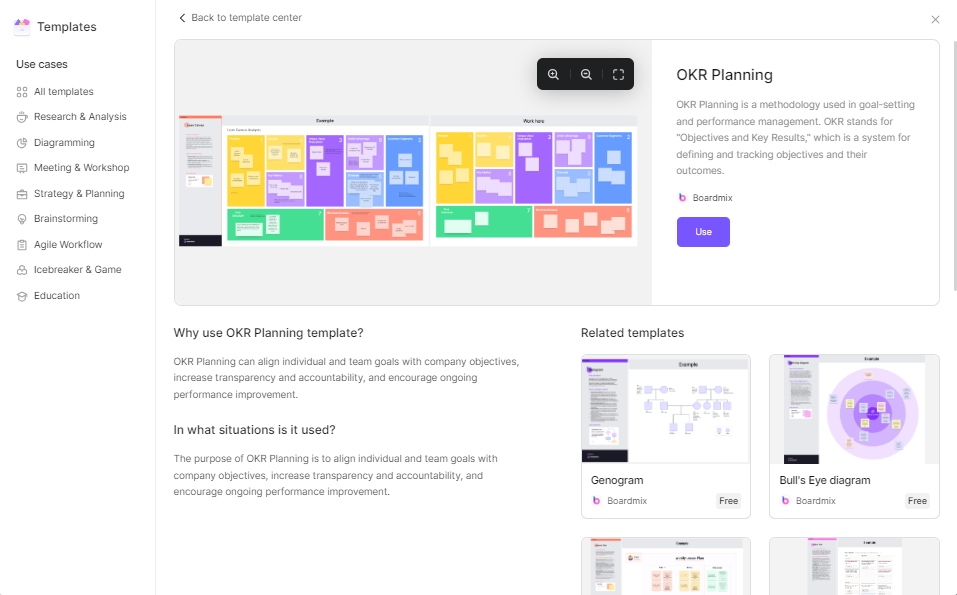
Boardmix is an innovative online tool that can streamline the management of Objectives Key Results (OKRs) and Key Performance Indicators (KPIs). With its intuitive interface and robust features, Boardmix allows organizations of all sizes to effectively set, track, and achieve their goals and objectives. Ready to take your business performance management to the next level? Here's how to get started with Boardmix:
1. Sign Up: Visit the boardmix.com and sign up for a new account. You can start for free and also can choose the plan that best fits your organization's needs.
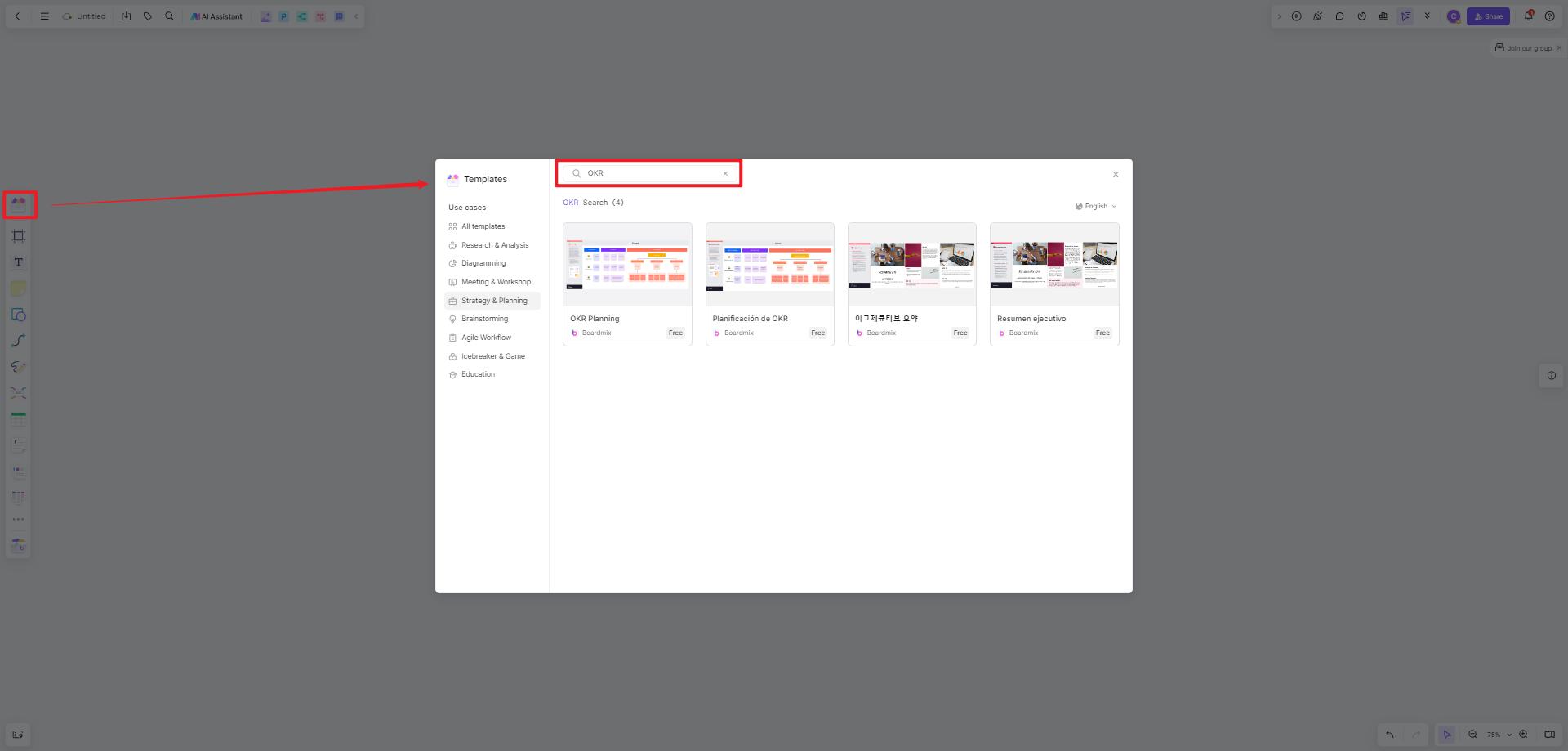
2. Set up Your OKR: Use the intuitive interface to create your initial OKR. Remember to make your objectives inspiring and key results measurable.
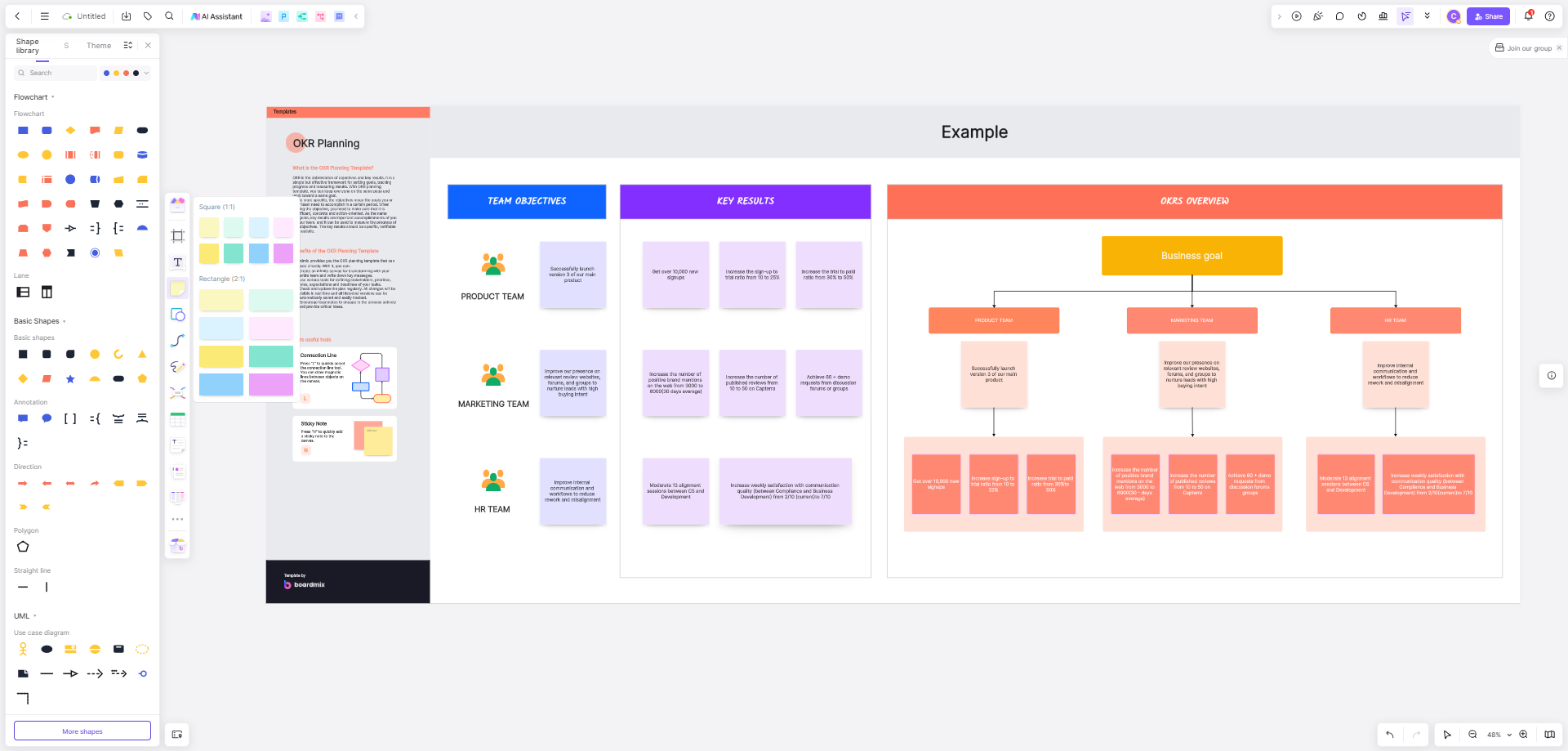
3. Create a board for management: Click the New board button and then you can start your program. Also, there are many ready-made templates for free, you can search for them in the Template library, or choose one project management tool on the left of the board.
4. Invite Your Team: Invite your team members to join the platform and align them with the company's strategic objectives.
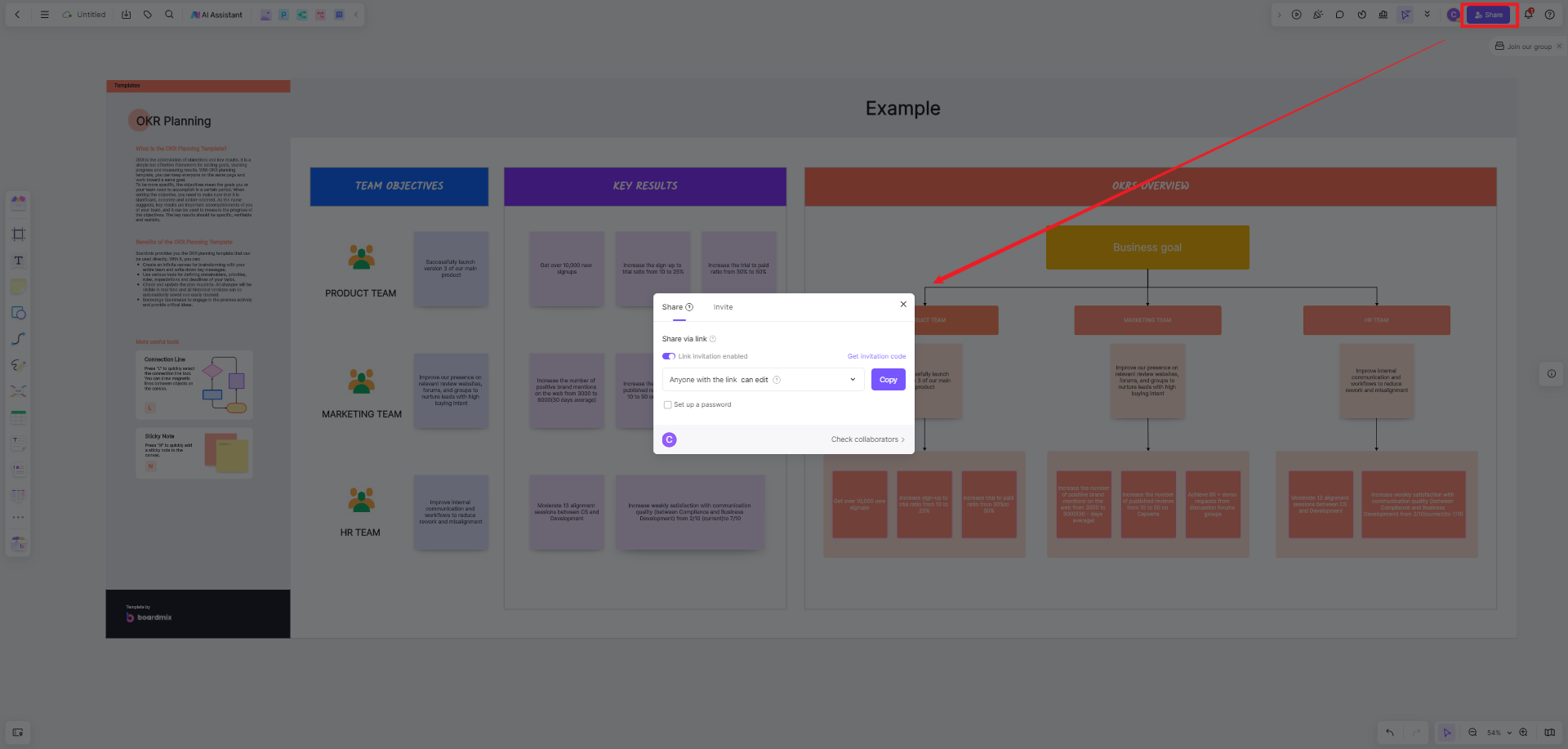
FAQ about the OKR planning template
How do you write an OKR plan?
There’s no specific way to write your OKR plan. Of course, you can trust digital OKR templates to provide the necessary sections you must fill in, including team objectives, key results, and the OKR overview. Some tips on how to draw your template can be found below.
- Invite various stakeholders to prevent any blind spots in objectives and strategies.
- Ensure to update your OKR plan. The framework lets you track your progress, so update the Status section with the recent developments. You can use colored sticky notes to emphasize your points. After all, the OKR goal is to achieve shorter company goals.
- When brainstorming, you can select the private mode to encourage individual insights instead of group thinking.







